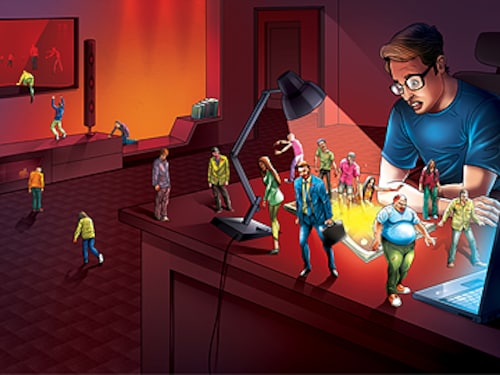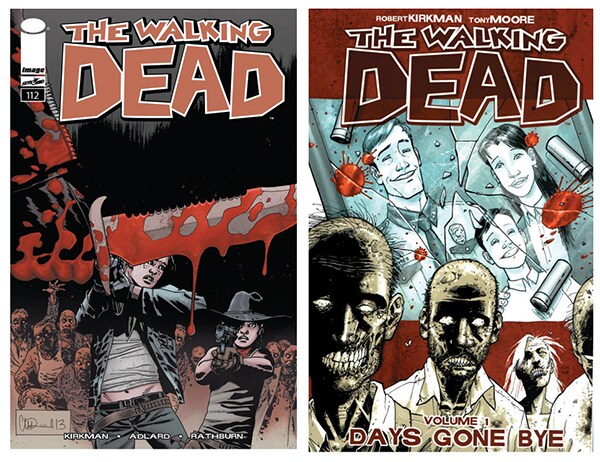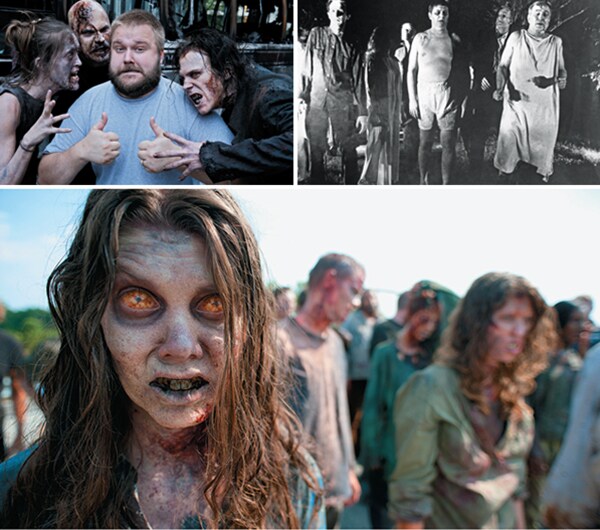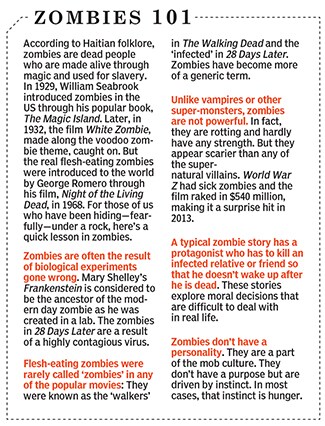How Zombies have taken over pop culture
Zombies are ruling American television and, consequently, global imagination. So, of course, Indian filmmakers and creators want a bite of the action too


Before there were zombies, there were vampires. A lot of vampires. And witches. And werewolves.
But now there are zombies. Mostly. Because while women, for the most part, bought into the world of vampires—think the Twilight series, its other-worldly drama and milky-white male lead—the gory starkness and believability of zombies cuts across genders, age groups and continents. Not surprisingly, the American television and movie business is bursting with the undead.
Few will disagree that most of the current zombie buzz is centered round the American post-apocalyptic television drama, The Walking Dead, which tracks the fortunes of sheriff Rick Grimes—played by Andrew Lincoln—as he attempts to survive flesh-eating zombies. Safe to say, the show is popular. Insanely popular. Consider that in October 2014, its fifth season premiered to a record viewership of 17.3 million, the highest for any cable drama in the US. It was also the most talked about show on Twitter with an average of 576,000 tweets being sent about each episode, according to a study by Nielsen.
But contrary to how this may appear to the recent convert, while TV may have evangelised the zombie it did not bring it to the mainstream. The first wave of re-animated, flesh-eating cannibals was ushered in over four decades ago by filmmaker George Romero in Night of the Living Dead. Released in 1968, Romero’s movie, which contemplates a situation when the dead stop playing dead and start to come alive, befuddled and enthralled audiences all at once. And, inevitably, it became a huge hit: The film made $20 million on a budget of $114,000. With it, the horror genre was rebooted. The nightmares worsened. The world woke up to zombies.
And now, almost five decades later, they are attacking our screens, both small and big, with renewed vigour. It’s time to be afraid, very afraid. And make money from it too.
For instance, World War Z did big business at the box office. It also benefited from its association with Hollywood royalty Brad Pitt as producer, which gave the concept even more publicity. What also went on to become a money- and TRP-spinner is The Walking Dead.
In 2010, Frank Darabont, director of prison break drama The Shawshank Redemption, adapted the comic series The Walking Dead written by Robert Kirkman for television. It has since become one of American prime time’s biggest shows, surpassing the likes of Breaking Bad and Game of Thrones. Inevitably, across the world, inspired writers and producers spawned their own versions of zombies. In 2013, Luke Kenny and Devaki Singh released Rise of the Zombie, a Bollywood film that interpreted zombies in the Indian context. “The zombie culture has never been explored within the Indian horror framework. We have had grotesque fabrications on some level with the Ramsay Brothers’s cult films. But nothing that told a non-supernatural origin story,” says Kenny.
Reason: Zombies are, largely, a Western concept. The average Hindi horror film buff has been typically served haunted havelis (mansions) and chudail (witch) stories the supernatural element has been kept alive through ghosts. But Kenny wanted to try a different route. As a former VJ and a prominent presence in the rock music scene, he was influenced by Michael Jackson’s Thriller video and, later, by movies such as Night of the Living Dead. “When the idea [of the movie] was discussed, it was definite that the story would have to be a discovery of what happens to a human being when faced with something that is out of its control. Thus, the approach was more of a drama as opposed to a blatant horror film,” says Kenny.  Trendsetter: Robert Kirkman started writing The Walking Dead, a zombie comic series, in 2003. It inspired a hit television show and has led to an explosion in the zombie genre
Trendsetter: Robert Kirkman started writing The Walking Dead, a zombie comic series, in 2003. It inspired a hit television show and has led to an explosion in the zombie genre
Along with Singh, he wrote the script and released the film in limited theatres. Rise of the Zombie did what it was meant to do. It didn’t get much critical acclaim, nor was it profitable, but it created curiosity about a genre. (The story was written as a three-film construct, so expect two more, perhaps more refined, editions of gore.)
Meanwhile, another Indian zombie movie, Go Goa Gone, which was released a month after Rise of the Zombie, found some commercial success. It helped that the light zombie comedy movie had the backing of actor Saif Ali Khan. The brainchild of Krishna DK and Raj Nidimoru, who had earlier made Shor in the City, the movie was targeting two types of audiences: Those who were aware—and passionate—about the zombie phenomenon and others who needed an introduction. And, to their credit, they did not shy away from the premise of biting zombies.
Not that zombies had a definitive premise to begin with. Romero’s Night of the Living Dead was inspired by horror novel I Am Legend by Richard Matheson, which talks about the last man surviving after most of the population has been turned into vampires. Matheson termed them ‘infected’ vampires the creatures operated in groups and were nothing like Dracula, the first vampire on earth, created by Bram Stoker in his 1897 Gothic horror novel Dracula. Romero’s Night of the Living Dead gave a twist to Matheson’s vampire theory. (And here’s a quick fact: The word ‘zombie’ wasn’t used at all in the movie instead, the creatures were called ‘ghouls’.)In Romero’s depiction, the zombie genre evolved through group psychosis as opposed to vampires that were always individualistic with origins in fantasy and sometimes in religious rituals.
With zombies, the origins were mostly scientific and are drawn from Mary Shelley’s Frankenstein, the first zombie-like creature created in a laboratory, way back in 1818.
Across depictions, zombies have been showcased as an urban phenomenon which starts with a virus that spreads out of a lab and infects a group of people. The contagion moves from densely populated areas such as cities into thinly populated regions. The chances of survival rise through retreat into low human density areas.
Take the case of The Walking Dead. The spread of zombies starts in the Atlanta Metropolitan area and then slowly creeps into the countryside in Northern Georgia. Anybody who wants to survive the ‘walkers’ (The Walking Dead never uses the word zombies they are referred as the ‘walkers’) is seen moving into the wilderness.
If you ask a zombie fan about why the genre has suddenly become so popular, they will point to Robert Kirkman’s comic series, The Walking Dead. He started writing it in 2003, soon after Danny Boyle completed 28 Days Later, a post-apocalyptic horror film about survival and group bonding. While the movie showed four survivors dealing with ferocious human beings in a classic zombie tale, Kirkman’s comics went a step ahead and created a universe where different types of characters bond and start their own ecosystems. And fans, world over, credit his narratives for the rise of the zombie phenomenon. And see the TV version as the show that is spawning a million others.
“I think the popularity [of zombies] has a lot to do with The Walking Dead. It is a television show that has only gained audiences over the last few years because of its merciless and honest storytelling about a zombie apocalypse that hits the audience in the heart,” says Aalok Joshi, one of India’s biggest comic collectors.
This kind of storytelling doesn’t exist in India, he points out. So to expect a classic zombie apocalyptical tale is nigh impossible on either the big or small screen in the country. “There are some writers who are attempting to write classic zombie comics but, again, these comics are restricted to a very niche audience. Breaking it out for the mainstream becomes difficult,” he adds.
 Night of the Living Dead image: Indiapicture
Night of the Living Dead image: Indiapicture
Horror heroes: (clockwise from left) A scene from The Walking Dead, one of the highest-rated TV shows in the US Robert Kirkman with ‘walkers’ (a term he uses for zombies in The Walking Dead) Night of the Living Dead was the first movie to show flesh-eating zombies
Alok Sharma, an independent filmmaker who is now creating content for Epic, a newly-launched television channel that focuses on fantasy stories and Indian mythology, believes that zombies are not a gimmick, as often misconstrued by viewers or readers. “If the world has to end, it is most likely that it will end in a classic zombie apocalypse. The whole thing is so scientific that it cannot be ignored. You can also look at it as an absence of free will. Zombies don’t have a soul. Are we not becoming soulless human beings?” he asks.
Zombies can also thank their country cousins, vampires, for the rise in their popularity. It is often held that vampires have failed to make a statement about the present state of human civilisation, unlike their cooler counterparts, zombies.
Vampires are descendants of Dracula, who had entered the bedrooms of American teenage girls in the nineties. And the supernatural creatures have become an intrinsic part of pop culture. American goth fiction author Ann Rice made a career out of writing vampire stories. Her most famous book, Interview with the Vampire: The Vampire Chronicles, was adapted into a film in 1992, starring Brad Pitt, Tom Cruise and Antonio Banderas. Starting in 2008, film adaptations of Stephenie Meyer’s The Twilight Saga series achieved huge success with audiences across the world. On television, shows such as True Blood and The Vampire Diaries became hits.
But while these movies and books captivated teenagers, in particular, vampires were inexplicable to geeks—and to a more mature audience—who sought logical explanations about a world where economic theories were collapsing. Biological and scientific breakthroughs coupled with a rise in terrorism signalled the possibility that inventions could fall in the hands of the wrong people. For many, the outbreak of ebola and dengue support the theories of zombie apocalypse. Again, a lack of clear global leadership and the spurt in breakaway groups in every corner points to a world that is absent of free will and out of control, both at the same time.
As Krishna DK, director of Go Goa Gone, points out, “Zombies are a strong creation because they do not have an agenda. They do not have personalities or, for that matter, emotions. They represent mobs that want to bite. They don’t have any other agenda. There are various interpretations but a senseless mob, to my mind, makes most sense about these creatures.”
Cormac McCarthy got it right in The Road, his book which won the 2007 Pulitzer Prize for best fiction. It is a story about a boy and his father on a journey in a post-apocalyptic world where civilisation has broken down. People are dying and there is no food. Those who are alive have turned into cannibals. The father has a gun with two bullets—one for himself and the other for his kid. There are no classic zombies in this world but there is the absence of free will, of one single adversary on the other hand, there is group psychosis and characters that keep the emotions on a high level.
“The zombie culture is an analogy and a metaphor for humanity gone wrong. As a consequence, there are the inadequacies of those in power to be able to do anything about it,” says Kenny. The Walking Dead is along similar lines. It is set in an apocalyptic environment in which civilisation has come to an end and people are turning into zombies. The comic books are in black and white with a linear story. The writer played with the psychology of the reader and bumped off popular characters or turned them into ‘walkers’ whenever the plot became intense.
For over a decade, comic book readers have stayed with the storyline even as Darabont decided to breathe life into it through the television show. The first episode was aired on October 31, 2010. The first season had an average viewership of 5.24 million which shot up to 13.3 million by the end of the fourth. Clearly, the audience refuses to let it go.
With only two films so far and no available writing in the form of novels or comics, the potential for similar growth in the zombie genre in India—in terms of homegrown content—seems limited. But never say never. The zombie bug can bite hard. Ask the Americans.
First Published: Feb 17, 2015, 06:00
Subscribe Now(This story appears in the Apr 16, 2010 issue of Forbes India. To visit our Archives, Click here.)
